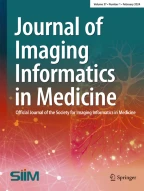Abstract
Imaging centers nationwide are seeking innovative means to record and monitor computed tomography (CT)-related radiation dose in light of multiple instances of patient overexposure to medical radiation. As a solution, we have developed RADIANCE, an automated pipeline for extraction, archival, and reporting of CT-related dose parameters. Estimation of whole-body effective dose from CT dose length product (DLP)—an indirect estimate of radiation dose—requires anatomy-specific conversion factors that cannot be applied to total DLP, but instead necessitate individual anatomy-based DLPs. A challenge exists because the total DLP reported on a dose sheet often includes multiple separate examinations (e.g., chest CT followed by abdominopelvic CT). Furthermore, the individual reported series DLPs may not be clearly or consistently labeled. For example, “arterial” could refer to the arterial phase of the triple liver CT or the arterial phase of a CT angiogram. To address this problem, we have designed an intelligent algorithm to parse dose sheets for multi-series CT examinations and correctly separate the total DLP into its anatomic components. The algorithm uses information from the departmental PACS to determine how many distinct CT examinations were concurrently performed. Then, it matches the number of distinct accession numbers to the series that were acquired and anatomically matches individual series DLPs to their appropriate CT examinations. This algorithm allows for more accurate dose analytics, but there remain instances where automatic sorting is not feasible. To ultimately improve radiology patient care, we must standardize series names and exam names to unequivocally sort exams by anatomy and correctly estimate whole-body effective dose.
Similar content being viewed by others
References
Maitino AJ, Levin DC, Parker L, Rao VM, Sunshine JH: Nationwide trends in rates of utilization of noninvasive diagnostic imaging among the medicare population between 1993 and 1999. Radiology 227:113–117, 2003
Levin DC, Rao VM, Parker L, Frangos AJ, Sunshine JH: Recent trends in utilization rates of abdominal imaging: the relative roles of radiologists and nonradiologist physicians. JACR 5:744–747, 2008
Sinclair WK, Adelstein SJ, Carter MW, Harley JH, Moeller DW: Ionizing radiation exposure of the population of the United States. Tech. Rep. 93, National Council of Radiation Protection, 1987
Kase KR et al: Ionizing radiation exposure of the population of the United States. Tech. Rep. 160, National Council of Radiation Protection, 2009
Brenner DJ, Hall EJ: Computed tomography: an increasing source of radiation exposure. NEJM 357(22):2277–2284, 2007
Brody A, Frush D, Huda W, Brent R: Radiation risk to children from computed tomography. Pediatrics 120(3):677, 2007
de Gonzalez AB, Mahesh M, Kim K, Bhargavan M, Lewis R, Mettler F, Land C: Projected cancer risks from computed tomographic scans performed in the United States in 2007. Arch Intern Med 169(22):2071–2077, 2009
Martin D, Semelka R: Health effects of ionising radiation from diagnostic CT. Lancet 367(9524):1712–1714, 2006
Amis JES, Butler PF, Applegate KE, Birnbaum SB, Brateman LF, Hevezi JM, Mettler FA, Morin RL, Pentecost MJ, Smith GG, Strauss KJ, Zeman RK: American College of Radiology white paper on radiation dose in medicine. JACR 4:272–284, 2007
DICOM Standards Committee: DICOM standard supplement 127: CT radiation dose reporting, 2007
DICOM Standards Committee: DICOM standard part 16: Content mapping resource, 2008
Radiation Exposure Monitoring: http://wiki.ihe.net/index.php?title=Radiation_Exposure_Management, accessed March 15, 2010
Goske M, Applegate K, Boylan J, Butler P, Callahan M, Coley B, Farley S, Frush D, Hernanz-Schulman M, Jaramillo D, et al: The Image Gently campaign: increasing CT radiation dose awareness through a national education and awareness program. Pediatr Radiol 38(3):265–269, 2008
National Radiology Data Registry: http://www.acr.org/SecondaryMainMenuCategories/quality_safety/NRDR.aspx, accessed March 15, 2010
White Paper: Initiative to Reduce Unnecessary Radiation Exposure from Medical Imaging. http://www.fda.gov/Radiation-EmittingProducts/RadiationSafety/RadiationDoseReduction/ucm199994.htm#_Toc253092884, accessed March 15, 2010
Neumann RD, Bluemke DA: Tracking radiation exposure from diagnostic imaging devices at the NIH. JACR 7(2):87–89, 2010
Cook T, Zimmerman SL, Maidment AD, Kim W, Boonn WW: Automated extraction of radiation dose information for CT examinations. J Am Coll Rad 7(11):871–877, 2010. doi:10.1016/j.jacr.2010.06.026
Christner JA, Kofler JM, McCollough CH: Estimating effective dose for CT using dose-length product compared with using organ doses: consequences of adopting International Commission on Radiological Protection Publication 103 or dual-energy scanning. Am J Roentgenol 194(4):881–889, 2010. doi:10.2214/AJR.09.3462
RadLex Playbook: http://www.rsna.org/Informatics/radlex_playbook.cfm, accessed January 11, 2011
McCollough CH, Leng S, Yu L, Cody DD, Boone JM, McNitt-Gray MF: CT dose index and patient dose: they are not the same thing. Radiology 259(2):311–316, 2011. doi:10.1148/radiol.11101800
Author information
Authors and Affiliations
Corresponding author
Rights and permissions
About this article
Cite this article
Cook, T.S., Zimmerman, S.L., Steingall, S.R. et al. An Algorithm for Intelligent Sorting of CT-Related Dose Parameters. J Digit Imaging 25, 179–188 (2012). https://doi.org/10.1007/s10278-011-9410-1
Published:
Issue Date:
DOI: https://doi.org/10.1007/s10278-011-9410-1
